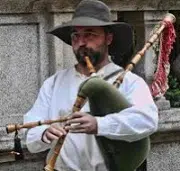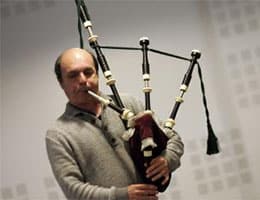 An analysis of the etymology of the term gaita takes us to the Gothic language, more precisely to the word gaits which translates as "goat" . The name bagpipe is a wind instrument that, according to the dictionary of the Royal Spanish Academy ( RAE ), resembles a flute .
An analysis of the etymology of the term gaita takes us to the Gothic language, more precisely to the word gaits which translates as "goat" . The name bagpipe is a wind instrument that, according to the dictionary of the Royal Spanish Academy ( RAE ), resembles a flute .
The most common use of the notion is specifically associated with the Galician bagpipe . This musical instrument is made up of a leather bag (usually goat, hence the etymological origin) with tubes attached to it. The musician blows through a tube and causes the air to accumulate in the bag ; Then, by pressing this bag, it causes the air to be expelled through another tube, which has holes that must be blocked or unlocked to generate different sounds.
It is estimated that some ancient peoples, such as the Celts, Romans and Babylonians, already used bagpipes. Although this instrument lost popularity over the years, it maintained its importance in Galician lands and in Great Britain .
The bagpipe is used on different types of occasions. It is possible to find it in military bands since its performance is an integral part of the parades . It can also be used at funerals and popular festivals .
Currently there are different types of bagpipes, each with its own particularities. To the Galician bagpipe we must add the Boto bagpipe , the Colombian bagpipe , the Gastoreña bagpipe and the Navarrese bagpipe , among others.
Although when thinking about this instrument we make the almost instant association with Ireland, Scotland and the Celtic peoples of northern Spain, it is important to note that the true origin of the bagpipe is not any of them. There is evidence of its existence in India, several hundred years before Christ.
In more precise terms, the first bagpipes documented throughout history date back to the 8th century BC. C., and they were in the north of the current Asian country. It is estimated that the Romans brought them to the West, based on texts that describe the enchantment that their sound caused in Emperor Nero when he heard a bagpipe for the first time.
 During the Middle Ages (a period that followed the Ancient Age and preceded the Modern Age, approximately between the 5th and 15th centuries) the use of the bagpipe focused on the preparation of soldiers to improve their performance in battle. The energy provided by the music of this instrument, with its powerful and penetrating notes, was ideal for leaving fears behind and focusing on strategy.
During the Middle Ages (a period that followed the Ancient Age and preceded the Modern Age, approximately between the 5th and 15th centuries) the use of the bagpipe focused on the preparation of soldiers to improve their performance in battle. The energy provided by the music of this instrument, with its powerful and penetrating notes, was ideal for leaving fears behind and focusing on strategy.
It is known that between the 12th and 14th centuries, the point in Europe in which the bagpipe was most popular was Galicia, and this was probably due to the pilgrimages that Santiago de Compostela received at that time.
As a curious fact, bagpipe students usually do not start with the instrument itself, but with what is known as a practice pointer . It is a type of flute, which is sold in various sizes and models, which does not have the typical bagpipe bag. It is important to buy one of good quality, because the cheapest ones usually produce unpleasant sounds.
The idea of bagpipes, finally, is also used in different ways depending on the region. It can be something annoying or silly , or even used as a colloquial adjective to refer to an individual born in Galicia . For example: “Stop the bagpipes and come help me,” “Having to travel two hours every time I want to visit my girlfriend is a bagpipe,” “The owner of the restaurant is a bagpiper who arrived in our country two years ago.”
